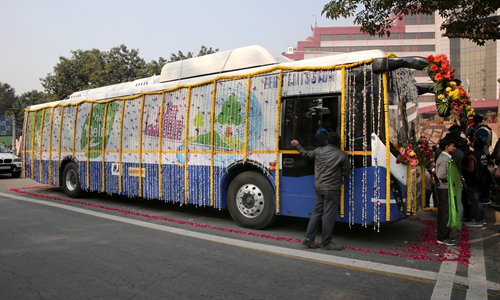HOME >> BUSINESS
China-India JV powers electric buses
By Xinhua - Global Times Source:Global Times - Xinhua Published: 2019/10/17 20:58:40
Olectra-BYD partnership prime example of bilateral cooperation

A view of an Olectra-BYD electric bus during a trial as a public transport to reduce pollution in New Delhi, India, on December 27, 2018. Photo: IC
In August 2013, when a K9 electric bus made by Chinese automaker BYD first arrived Chennai, India, local customs registered it as a test vehicle due to a lack of knowledge about how much tax should be levied.Roughly six years later, however, batches of electric buses newly rolling off the line at BYD's Chennai factory have hit the roads across India, representing win-win outcomes of bilateral cooperation.
In 2007, BYD started business in the southern Indian city of Chennai, the heartland of India's auto industry.
Six months after the BYD K9 electric bus first arrived at the Chennai Port, the Indian government issued its first-ever electric bus operation license. Seizing the chance, BYD kickstarted K9 bus trials in the southern Indian city of Bangalore.
The first three months went off without problems, laying a solid foundation for BYD's localization and cooperation.
Olectra-BYD, a joint venture (JV) between BYD and India's Olectra Greentech, holds 57.5 percent of the Indian market in fully operational electric buses. More than 200 BYD electric buses run in major cities like Mumbai, Pune and Bangalore.
The company's buses deliver a comfortable travel experience. In 2016, a BYD bus hit the road in the northern state of Himachal Pradesh at an altitude of nearly 4,000 meters, the highest for such operations in India.
In September, five K7 electric buses were delivered in Nagpur in central India as one of the first women-only units, according to BYD.
"Based on the operating records, these electric buses are really great," Sheikh Bar, depot manager of the Telangana State Road Transportation Cooperation, told the Xinhua News Agency, noting that BYD buses are better as they run with zero noise and zero emission, compared with some 4,000 buses in Hyderabad, the capital city of Telangana, that are mostly powered by liquefied natural gas and diesel.
With a range of 300 km per charge, the average operating cost of a BYD electric bus is about 5 rupees (7 US cents) per km, less than one-third of a fuel bus.
"They look fantastic and modern, plus eco-friendly too!" said a message on Indian social media on reports of testing operations. "Thank you very much for the partnership between the Chinese company and Indian company that built this bus for us," said another.
Joint efforts
The success of the JVs between BYD and Olectra Greentech, a diversified Indian company that's listed in Mumbai, could be attributed to catering to the needs of the public and the Indian government's vision of future public transportation, said Executive Director of BYD India Zhang Jie.
In 2015, BYD and Olectra Greentech set up a bus design and assembly facility in Hyderabad in support of the Indian government's strategic planning for "Make in India." It now has an annual capacity of 1,000 electric buses.
In December 2018, the company's Chennai factory started producing the chassis and batteries of BYD's K7 and K9 buses. It is expected to create some 200 jobs with production in full swing.
For the Indian government, the company's environmentally friendly and energy-efficient vehicles could help it achieve its goal of electric mobility. The government plans to have 30 percent of newly registered private vehicles and 60 percent of those in public transportation going electric by 2030, which could cut 846 million tons of carbon dioxide by then.
"We are glad to see the launch of a new phase of electric vehicle programs by the Indian government, which is in line with the effort by BYD to push for electrification of public transport globally," said Liu Xueliang, managing director of BYD Asia Pacific.
"BYD will continue to work with our local partners and customers for the electrification of transport in India," Liu added.
Posted in: INDUSTRIES